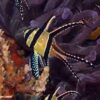Dragons in Mythology and Their Influence on Folk Life
Dragons have been one of the most powerful and enduring symbols in mythology across cultures. Unlike the fearsome, fire-breathing beasts of Western folklore, dragons in Eastern mythology, particularly in Chinese, Japanese, and Vietnamese traditions, are seen as benevolent creatures, embodying wisdom, strength, and cosmic harmony.
These legendary beings have profoundly shaped folk beliefs, rituals, and cultural traditions, playing vital roles in spirituality, agriculture, weather control, and community unity. This article explores the presence of dragons in mythological tales and their deep influence on everyday life in various cultures, particularly within East Asia.
1. The Mythological Origins of Dragons
1.1. The Primordial Dragon: A Force of Creation
In many ancient mythologies, dragons are regarded as primal beings responsible for shaping the world.
- Chinese Mythology: The legendary dragon Pangu (盘古) is often associated with the creation of the universe. Some stories suggest that as Pangu died, his breath became the wind and clouds, his blood turned into rivers, and his body transformed into mountains. Some versions even depict him with dragon-like attributes.
- Japanese Mythology: The dragon Ryūjin (龍神), the god of the sea, was believed to control the tides and the weather, influencing the balance of nature.
- Vietnamese Mythology: The Vietnamese people trace their ancestry to the legendary dragon Lạc Long Quân, who, according to myth, fathered the first Vietnamese rulers.
These narratives highlight how dragons were perceived as cosmic forces responsible for shaping civilizations and the environment.
1.2. Dragons in the Cycle of Life and Death
Dragons in many mythologies also serve as protectors of sacred knowledge, divine guardians, and beings associated with life, death, and rebirth.
- In Daoism, dragons are seen as immortal celestial beings, guiding souls to enlightenment.
- In Buddhist stories, dragons often guard sacred scriptures and serve as protectors of wisdom.
- In Japanese folklore, some dragons are shape-shifters who test human morality, offering rewards to the righteous and punishing the wicked.
The dragon’s role in determining fate and the cycle of life and death is a recurring theme in folklore, reinforcing its presence in religious and spiritual traditions.
2. Dragons as Symbols of Protection and Power
2.1. Imperial Symbolism and Divine Authority
Throughout history, rulers have used dragon imagery to assert their divine right to rule.
- In China, the dragon was the exclusive symbol of the Emperor, who was believed to be the “Son of the Dragon.” The five-clawed dragon was reserved for the emperor alone, symbolizing absolute power.
- In Vietnam, emperors incorporated dragon motifs in palaces, temples, and military banners to invoke celestial protection.
- In Japan, dragons were seen as guardians of sacred sites and treasures, often depicted in temple architecture and artwork.
This connection between dragons and authority, wisdom, and protection made them central figures in governance and political identity.
2.2. Dragons in Local Folk Beliefs and Rituals
Beyond royal symbolism, dragons were deeply embedded in folk rituals and community traditions.
- Dragon Dance (舞龙, Wǔ Lóng): This traditional Chinese performance, often seen during the Lunar New Year, symbolizes good luck, prosperity, and protection from evil spirits.
- Water and Rain Rituals: In many rural communities, people prayed to dragon deities for rain and good harvests. The Dragon Kings (龙王, Lóng Wáng) were revered as water gods who controlled rivers, lakes, and rainfall.
- Dragon Totems in Villages: Many old villages in China, Vietnam, and Korea have dragon carvings or totems at their entrances, believed to ward off evil and bring prosperity.
These customs reflect how dragons remain an active force in everyday folk life, guiding and protecting communities.
3. The Dragon’s Influence on Natural Phenomena and Agriculture
3.1. Dragons as Masters of Weather and Water
In ancient folk beliefs, dragons were responsible for natural elements like rain, storms, and wind.
- In China, the Four Dragon Kings (四海龙王, Sì Hǎi Lóng Wáng) each ruled over one of the four seas and controlled rainfall. During droughts, people would offer sacrifices to these dragon deities to seek their favor.
- In Vietnam, the dragon was believed to live in the depths of rivers and lakes, ensuring balance in nature.
- In Japan, the dragon Ryūjin was believed to reside in the ocean and control the tides, protecting fishermen and coastal communities.
Farmers depended on these dragon legends to understand weather patterns, aligning their agricultural practices with seasonal cycles.
3.2. Dragon Totems in Agriculture and Livelihood
In some rural areas, people believed that carving dragon symbols on farm tools or village gates would bless their crops and protect them from disasters. Many rice-growing regions still maintain dragon-shaped irrigation channels, believing these structures will guide water efficiently and bring abundant harvests.
4. Dragons in Popular Folktales and Storytelling
4.1. The Legend of the Dragon Gate (鱼跃龙门, Yú Yuè Lóng Mén)
One of the most famous folk legends in Chinese culture tells of a koi fish that swims against the current and leaps over the Dragon Gate, transforming into a dragon.
- This story symbolizes perseverance, strength, and the rewards of determination.
- It has inspired generations of students and scholars who aim for success, much like the koi striving to become a dragon.
4.2. The Dragon Princess and Human Love Stories
Many folktales feature dragons transforming into humans and falling in love.
- In Chinese legends, dragon princesses sometimes take human form to test the kindness of mortals.
- In Vietnamese folklore, the legend of Lạc Long Quân and Âu Cơ tells of a dragon lord who married a fairy, giving birth to the first Vietnamese people.
- In Japan, Ryūjin’s daughter falls in love with a human fisherman, showcasing the bond between the celestial and earthly realms.
These myths illustrate how dragons are not just distant celestial beings but also part of human emotions, struggles, and love stories.
5. Modern Influence: Dragons in Contemporary Culture and Identity
5.1. Dragons in Festivals and Public Celebrations
Even in modern times, dragons remain central to cultural festivals:
- The Dragon Boat Festival (端午节, Duānwǔ Jié): This annual event, held in China and other Asian countries, honors the dragon spirit while promoting community unity through boat racing.
- Dragon Symbolism in Business: Many Asian companies incorporate dragon names and images to represent strength, ambition, and success.
- Martial Arts and Dragon Imagery: Kung Fu techniques such as the Dragon Style (龙形拳, Lóng Xíng Quán) draw inspiration from the grace and power of dragons.
5.2. Dragons in Pop Culture
Dragons continue to inspire books, films, and art. From the majestic Shenron in Dragon Ball to the spiritual Haku in Spirited Away, dragon mythology continues to evolve while maintaining its deep cultural significance.
Conclusion
Dragons are far more than mythical creatures—they are guardians of nature, protectors of communities, and symbols of wisdom and perseverance. From ancient myths to modern traditions, their influence remains deeply rooted in folk life. Whether through rituals, storytelling, art, or cultural identity, dragons continue to shape the worldviews of millions, bridging the past and the present in a timeless legacy.


